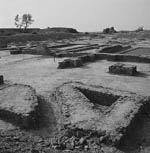Language, whether spoken or nonverbal,
both divides and unites. Language is one of the primary means by which
people express their personal and group identity. An understanding of
the language(s) utilized by the Harappan Civilization and their
distribution would go a long way toward distinguishing how the
population perceived the world.Several possibilities have been
offered for the language of the Harappan Civilization: Sumerian,
Dravidian, Indo European, Vedic Sanskrit, and unknown languages.
Cambridge scholar Kinnier-Wilson feels that form of Sumerian He posits
this hypothesis primarily from archaeological and historical
interpretations and not on linguistic data. No evidence for a Sumerian
or Akkadian sub stratum or place names.
The current consensus, among scholars not fanatics, is that the
primary language represented by the Harappan script is related to modern
Dravidian. Marshall was the first to suggest a linguistic link between
the Harappans and Dravidians (Marshall, 1931). His theory was based on
the assumption that the Indo-Aryan dialects found in modern India are
invasive. This invasion was dated from other sources to after the
Harappan Civilization. The dating was not reliant on archaeological
remains but was rather based on the then accepted linguistic paradigm of
Indo-European origins, movement, and chronology.
Dravidian is currently spoken by many indigenous groups of South
India. Two isolated groups of spoken Dravidian can be found in Iranian
and Pakistani Balochistan and Northeastern India. These isolated
dialects seemed to support the contention that in the distant past
Dravidian existed as a major if not the dominant language group.
A variety of Dravidian loan words (i.e., phalam- ripe fruit, mulcham-
mouth, khala- threshing floor) in Vedic Sanskrit suggests that the two
languages existed for a time in close proximity. A substratum of
Dravidian may be represented in Vedic Sanscrit by the existence of
retroflex consonants which do not occur in Iranian or European languages
(Rahman, 2000).
David McAlpin calls Elamite a cognate of Dravidian (McAlpin David,
1975). 20% of Dravidian and Elamite vocabulary are cognate; a further
12% are probable cognates (1975). Dravidian and Elamite are similar in several ways. They posses
similar second person pronouns and parallel case endings (McAlpin David,
1975). Elamite and Dravidian have identical derivatives, abstract nouns,
and the same verb stem+tense marker+personal ending structure (1975).
Further, both have two positive tenses a ‘past’ and a ‘non-past’ (1975).
The Indo-Aryan languages entered the subcontinent in two distinct
waves. The first was Dardic around 2000 B.C.E. It entered in the
northwest and stopped just over the mountains. The second form entered
at approximately 1400 B.C.E. and quickly became dominant.
Some day, the question as to what language(s) was utilized in the
Harappan Civilization will be answered. The most promising avenue lies
in that it was literate. A script was developed which is
probably syllabilic. This conclusion is based on the number of signs in
the script. Far to many for alphabetic and too few for it to be
 logographic.
logographic.
Harappan Script inscriptions range in size from isolated signs to 26
characters in length. It was utilized in many types of inscriptions,
including: seals, grafitti, potters marks, etc. The script was written from right to left with a
few being boustrophedon.
There is as much disagreement as to when and where the Harappan
Script originated as to what language it represented. Durrani, Lal, Khan
and Thapar suggest the early Kot Dijian potter’s marks as a beginning
for Harappan Script (Rahman, 2000). Asko Parpola suggests a
disconformity between the early graffiti and potter’s marks and the
Harappan Script. Writing moved from a center around the Indus to other
parts of the civilization. No writing or seals found at many sites in
the pre-Harappan (Kalabangan)
Paul Rissman in studying the Harappan seals with a unicorn motif
identified two stylistic groupings. In the first, the unicorns are
decorated with hatching on the faces. This form is associated with
Harappa and the Sarasvati River sites. The second group of unicorns have
collared necks and are found in the south around Mohenjodaro. (Insert
illustrations for both)
Numerous seals displaying Harappan script have been excavated in
Mesopotamia and the Persian Gulf. Seals from the Gulf have been
recovered from Lothal and off Bet Dwarka Island. During the Ur III
Period, a Harappan village is reported to have existed in Lagash. The
inhabitants are often referred to as "new Sumerians." Those living in
Mesopotamia may have served as agents of trade. Parpola and Brunswig
have located several references to people with Meluhha as a part of
their name.
During the Akkadian Period, Meluhha trade enclaves were located
throughout the Gulf and Mesopotamia. In ca. 2370 B.C.E. during the reign
of Sargon I, references to ‘holder of a Meluhha ship.’ A greenstone seal
in the Louvre self reports itself as the former was the property of a
translator of the Meluhhan language De Clercq and Menant, 1888. A seal
dating to ca. 2250 BCE British Museum lists enemies of King Naram-Sin,
among them is a 'man of Meluhha' by the name of _ibra. Trade and close
political contacts between Mesopotamia and the Harappan Civilization
presents the possibility that bilingual texts exist and will eventually
be uncovered.
According to Fairservis, the Harappan Civilization utilized a base 8
numerical system (1975). He based this determination on the octesimal
progression in both the system of weights and the numbering associated
with the script. There is no signs of the use of other systems. In fact
the system of weights was used in Dilmun (Bahrain) and in Oman.
Possehl
At Mohenjodaro, 62% of script is from the Lower City not from the
Citadel (Fairservis, 1975).
graduated scale (Tharpar, 1973).



